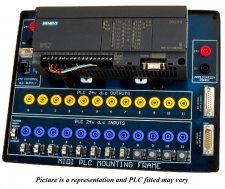-
Allen Bradley Micro800 Series
ViewThe Bytronic PLCA1 is a PLC trainer with the Micro800 series PLC fitted to a plastic box and a front panel with clear indications of the connections to the PLC. Using the prewired connections to the 4MM terminals or D connectors, the risk of damage to the PLC is minimised, as there Is no requirement to wire to the PLC directly. Diodes are fitted internally to protect from incorrect connections and a fuse fitted to protect the PLC.
Also, available as an optional extra, is the Allen-Bradley Micro800 Remote LCD Display. This connects to the controller’s embedded RS232 port and works as accessory for the Micro820 controller. With 4 or 8 lines of ASCII text and a tactile keypad, it can be used as a simple HMI. Its system menu is available in multiple languages for direct viewing and editing of controller variables. Controller’s Ethernet address can also be easily set from the menu. Supports front panel mounting as well as DIN rail mounting next to the controller.
The trainer gives access to the PLC’s I/O capabilities providing an effective means for the student to test and debug the program prior to connecting to the application.
LEDs clearly indicate the Input and Output operations. Simulation of inputs is possible using the built-in switches.
All inputs and outputs are available through the colour coded safety sockets (4 mm) and ‘D’ type connectors.
-
Mitsubishi Fx3
ViewThe Mitsubishi FX3s PLC is the latest in the FX3 series of PLC by Mitsubishi. The PLC is fixed to a pre-wired PCB that enables easy connections. The trainer gives access to the PLC’s I/O capabilities providing an effective means for the student to test and debug the program prior to connecting to the application. All inputs and outputs are available through the colour coded safety sockets (4mm) and ‘D’ type connectors. Simulation of inputs is possible using the built-in switches.
The controllers of the FX3S is designed to handle basic control task, it has a standard RS422 interface port for serial communications. A USB port (mini B) permits connection to a PC for high speed programming uploads and downloads along with monitoring. The FX3S has a built in EEPROM that can store up to 16,000 steps, 4,000 steps are reserved for the PLC program and up to 12,000 steps can be used for comments, and processes basic instructions in 0.21µs, making the FX3S an autonomous and very service-friendly system. For programming of the FX3S the GX Works2 programming software is used.
-
Siemens S7-200
ViewThe Bytronic PLCSF range consists of a mounting frame and PLC combination based around a Siemens S7-200. The Simatic S7-200 family of programmable controllers are a compact and powerful micro PLC solution for automation tasks. They are also easily expandable with various digital and analogue modules available. The S7-200 communication port connects to a PC allowing the CPU to be programmed using Siemens STEP7 Micro/WIN32 software. The mounting frame gives easy access to the PLCs I/O capabilities providing an effective means for the student to test and debug their program prior to connecting to the application.
-
Automated Production System
ViewThe Automation Production System is comprised of modules with varying functions that are electrically and mechanically linked, and when combined simulate an actual industrial process such as material dispensing, sorting of products, processing, and storing. The APS is designed to enables students to acquire knowledge of automation and production systems using PLC programming with the aid of sensors and actuators in the area of mechatronics.
The APS is constructed on an aluminium frame and can be mounted on a bench or supplied with a support stand. The APS has an operating console with on/off switches, emergency stop switch and PLC control with the I/O connections, electrical and pneumatic.
The functionally of the APS is to allow students to study the automation process and to understand how to control various modules to ensure they work together. The APS uses a bottling plant as the process with containers being placed onto the conveyor belt. The presence/absences of a container is detected using sensors and if present the containers are moved to the linear conveyor system. The linear conveyor moves each container onto the two axis pick and place module where the pneumatic gripper of the transfer unit picks up the container and places it onto the indexing rotary table. The motorised rotary module will index the container through to the volumetric filling modules where the container is filled. The container is then capped at the capping module and the containers are transferred from the rotary module to the weighing module. Once weighing is complete the XY palletising module will store the finished item in the pallet section.
The process allows the control of production using a series of modules that are independently controlled and require the modules to be synchronised for the operation to be performed successfully and is representative of a full-size production system.




